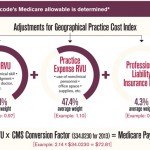From there, the RUC makes its value recommendations to the CMS, which usually adopts them, Dr. Laing says. “Statistically, the CMS accepts the RUC’s recommendations 80% of the time, and the other 20%, it modifies them.”
In addition, the RUC helps value new and altered codes that are assigned and defined by the AMA’s Current Procedural Terminology (CPT) committee. “For example, the CPT may split a code that it feels has become too broad in scope, perhaps because physicians have begun using a procedure in different ways to treat different groups of patients,” Dr. Laing explains. For a new procedure, the CPT would define the procedure and assign it a new code. Then those new and changed codes go to the RUC to determine their relative values.
The complexity of evaluating a wide range of specialty services highlights the need for rheumatologists to be involved. “The CMS would happily value our procedures for us,” Dr. Laing says. “But having medical societies—including the ACR— present during the discussion can ensure that the RUC has a much more accurate picture of the work that’s being done and, therefore, how it should be valued.”
Complex but Necessary
Dr. Barré attended his first RUC meeting in September, where he said the complexity of the process became apparent. “The meeting was incredibly technical and introduced me to a whole new alphabet soup of acronyms associated with healthcare funding. It felt a bit like trial by fire,” he says with a laugh. “Fortunately, my role as a trainee at that meeting was to observe and get a sense of how the RUC process works and how it influences the CMS’s incredibly important job of making decisions about the rate structure.”
That first meeting solidified his assessment that ACR representation plays a key part in how its members get reimbursed and, consequently, affects the care they can provide to their patients. It also showed why it is so crucial for ACR members to make time to fill out RUC surveys. “At the RUC, it isn’t enough for us to simply say that a particular procedure demands this amount of time and effort; we have to have surveys from our members to show it. It’s the only way that we can make a compelling argument for why we should be paid for the work that all of us do in rheumatology,” he says. “That’s why we need our members to fill out those surveys.”
